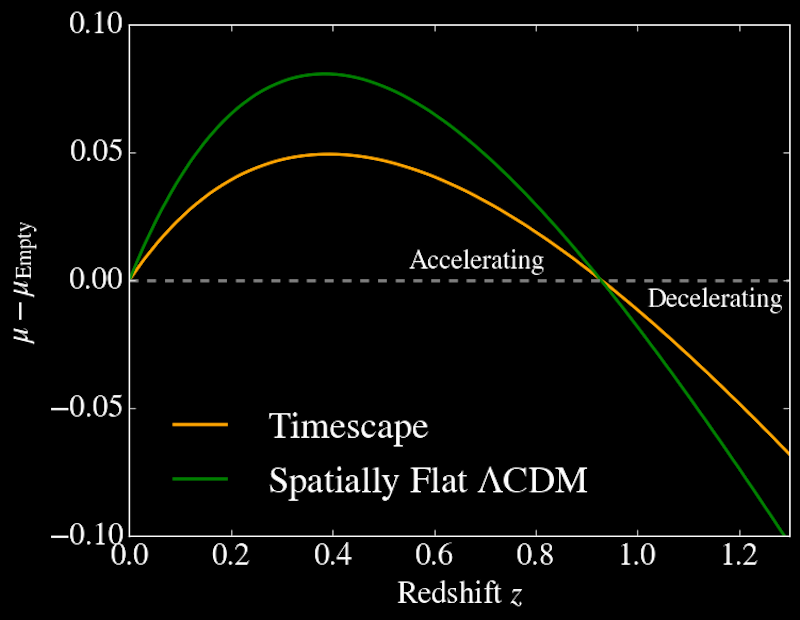 The difference in the magnitudes of supernovae in the ΛCDM and Timescape cosmologies and the magnitudes the supernovae would appear to have in an empty universe (horizontal dashed line). Both models show recent apparent acceleration following earlier deceleration. In the Timescape model this is not a real effect, however, and the curve is flatter than the ΛCDM case. Credit: Lawrence Dam, Asta Heinesen and David Wiltshire
The difference in the magnitudes of supernovae in the ΛCDM and Timescape cosmologies and the magnitudes the supernovae would appear to have in an empty universe (horizontal dashed line). Both models show recent apparent acceleration following earlier deceleration. In the Timescape model this is not a real effect, however, and the curve is flatter than the ΛCDM case. Credit: Lawrence Dam, Asta Heinesen and David Wiltshire
Sept. 13, 2017 (Phys.org) -- The accelerating expansion of the Universe may not be real, but could just be an apparent effect, according to new research published in the journal Monthly Notices of the Royal Astronomical Society.
The new study -- by a group at the University of Canterbury in Christchurch, New Zealand -- finds the fit of Type Ia supernovae to a model universe with no dark energy to be very slightly better than the fit to the standard dark energy model.
Dark energy is usually assumed to form roughly 70 percent of the present material content of the Universe. However, this mysterious quantity is essentially a place-holder for unknown physics.
Current models of the Universe require this dark energy term to explain the observed acceleration in the rate at which the Universe is expanding. Scientists base this conclusion on measurements of the distances to supernova explosions in distant galaxies, which appear to be farther away than they should be if the Universe's expansion were not accelerating.
However, just how statistically significant this signature of cosmic acceleration is has been hotly debated in the past year. The previous debate pitted the standard Lambda Cold Dark Matter (ΛCDM) cosmology against an empty universe whose expansion neither accelerates nor decelerates. Both of these models though assume a simplified 100 year old cosmic expansion law -- Friedmann's equation.
Friedmann's equation assumes an expansion identical to that of a featureless soup, with no complicating structure. However, the present Universe actually contains a complex cosmic web of galaxy clusters in sheets and filaments that surround and thread vast empty voids.
(more)
READ MORE: Phys.org











